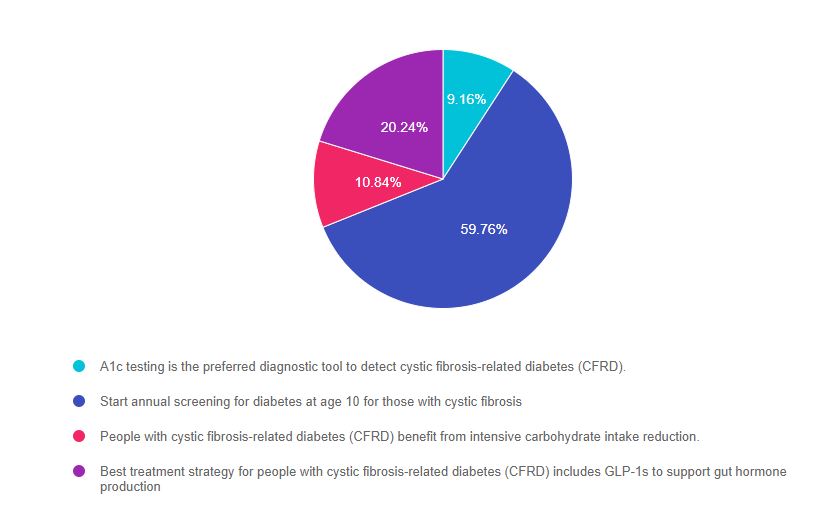
Our November 3rd Question of the week quizzed test-takers on cystic fibrosis and hyperglycemia. The majority of respondents (60%) chose the correct answer! Great job. Even though most of you got it right, we think it is an important topic to explore and discuss.
Before we start though, if you don’t want any spoilers and haven’t tried the question yet, you can answer below: Answer Question
Question: Which of the following is accurate regarding cystic fibrosis-related diabetes?
Answer Choices:
- A1c testing is the preferred diagnostic tool to detect cystic fibrosis-related diabetes (CFRD).
- Start annual screening for diabetes at age 10 for those with cystic fibrosis-related diabetes (CFRD).
- People with cystic fibrosis-related diabetes (CFRD) benefit from intensive carbohydrate intake reduction.
- The best treatment strategy for people with cystic fibrosis-related diabetes (CFRD) includes GLP-1s to support gut hormone production.

As shown above, the most common choice was option 2, the second most common answer was option 4, then option 3, and finally option 1.
Getting to the Best Answer
If you are thinking about taking the certification exam, this practice test question will set you up for success. Test writers anticipate possible answers based on the details in the question. They will wave those “juicy answers” right under your nose. Your job is to weed through the particulars, pluck out the most important elements and choose the BEST answer.
Cystic fibrosis is associated with hyperglycemia
Cystic fibrosis is a hereditary disease that affects the lungs and digestive system. The body produces thick and sticky mucus that can clog the lungs and obstruct the pancreas.
Cystic fibrosis-related diabetes (CFRD) is the most common comorbidity in people with cystic fibrosis, occurring in about 20% of adolescents and 40–50% of adults. If not treated adequately and promptly, it can lead to infections and weight loss. Learn more below.
Answer 1 is incorrect. 9.16% chose this answer, “A1c testing is the preferred diagnostic tool to detect cystic fibrosis-related diabetes (CFRD).” ADA recommends using the OGTT screening test to detect CFRD early on so insulin therapy can be provided.
According to ADA 2020 Standards, “A1C is not recommended for diagnosis of diabetes in children with cystic fibrosis”. That might change in the future since publications suggest that an A1C cut point lower than 5.4% (5.8% in a second study) would detect more than 90% of cases and reduce patient screening burden.
Answer 2 is correct. 59.76% of you chose this answer, “Start annual screening for diabetes at age 10 for those with cystic fibrosis-related diabetes (CFRD).” Great job.
According to ADA, “Annual screening for cystic fibrosis-related diabetes (CFRD) with an oral glucose tolerance test should begin by age 10 years in all patients with cystic fibrosis not previously diagnosed with CFRD.” Since CFRD occurs in about 20% of adolescents and 40–50% of adults, annual testing is important for prompt identification. People with CFRD also need to know the signs of hyperglycemia (especially unexplained weight loss) so they can receive immediate treatment to prevent weight loss and infections.
Answer 3 is incorrect. About 10.84% of respondents chose this, “People with cystic fibrosis-related diabetes (CFRD) benefit from intensive carbohydrate intake reduction.” This is not the best answer because people with CFRD often need up to 4,000 calories a day just to maintain their weight. Most important is to encourage them to eat as usual and cover with insulin. Weight maintenance while getting glucose to target are two big priorities.
Finally, Answer 4 is incorrect. 20.24% chose this answer, “Best treatment strategy for people with cystic fibrosis-related diabetes (CFRD) includes GLP-1s to support gut hormone production.” According to ADA, insulin therapy is the preferred treatment to lower glucose and maintain body weight.
People with CF make less of the pancreatic enzymes important for digestion, but GLP-1 hormones released from the intestine are intact.
More info on CFRD
For more information on CF and management of CFRD, please see these care guidelines; Clinical care guidelines for cystic fibrosis-related diabetes: 2010
We hope you appreciate this week’s rationale! Thank you so much for taking the time to answer our Question of the Week and participate in this fun learning activity!
Want more exam practice questions? Enroll in our Test Taking Toolkit with 220+ Practice Questions!
“This is one of the best review courses I’ve ever taken.”
“I learned so much from the CDCES Exam Prep Toolkit. I now have an assessment after taking the practice exam on the areas I need to focus my studying.”
Student Feedback

Whether you are preparing for the CDCES or BC-ADM exam, this test-taking toolkit is designed to prepare you for success. This toolkit includes two courses with over 200 practice questions to help you prepare and simulate the exam. Plus, we have added a FREE bonus course, Language, and Diabetes – What we say matters. Coach Beverly added this course because she believes it contains critical content for the exam and for our clinical practice!
Sign up for Diabetes Blog Bytes – we post one daily Blog Byte from Monday to Friday. And of course, Tuesday is our Question of the Week. It’s Informative and FREE! Sign up below!
[yikes-mailchimp form=”1″]Accreditation: Diabetes Education Services is an approved provider by the California Board of Registered Nursing, Provider 12640, and Commission on Dietetic Registration (CDR), Provider DI002. Since these programs are approved by the CDR it satisfies the CE requirements for the CDCES regardless of your profession.*
The use of DES products does not guarantee the successful passage of the CDCES exam. CBDCE does not endorse any preparatory or review materials for the CDCES exam, except for those published by CBDCE.









